An Overview of Bassdozer Spinnerbait Head Styles
When customers are faced with choosing between Style A, B, C, D, F, H, N, R, T, and standard or hidden head styles, I often get asked which head to use when. Truth be known, these are all excellent head styles. They really are a collection of some of the most productive and most popular head shapes in the spinnerbait industry since it's inception. Some like Styles A, B, C and N are venerable classic mainstays that have always caught and always will. Others like Styles D, F, H, R and T are the very latest, greatest styles. You can fish with confidence when you use any of these head styles. Please enjoy learning more about them all here.Style A Spinnerbait
You'll see this same head shape sold under several different brand names. Style A is a highly popular style that several tackle companies incorporate into their product lines. It has been around for many years. What makes it so successful for so long are its super thin, flat sides streamlined to slice deeply into the water. This head shape works against the uplift generated by the blades, so it stays deeper than regular spinnerbaits throughout the retrieve. If you want to get deep in the water, especially in a tidal river or current, this head is designed to do that.Best of all, no matter where or how you use it, this head shape presents an attractive deep-bodied baitfish profile.
There are no hard and fast rules for spinnerbaits but I favor this head shape with deeper-cupped blades and with faster-moving, deeper-sinking versions of Willows or Indianas, either: 1) double Willows, 2) double Indianas, 3) front Indiana back Willow or 4) front Willow back Indiana blade pairs.
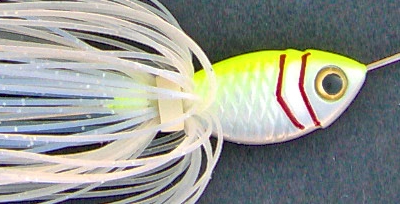
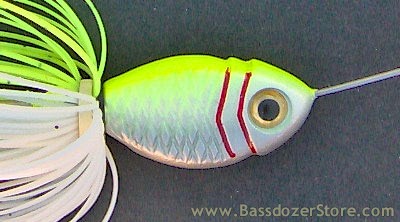
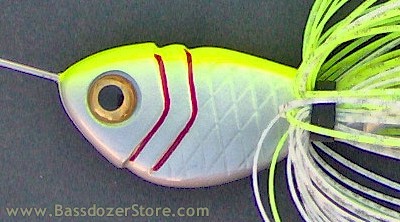
From top down: 1/2 oz Style A, 1 oz Style A, 1-1/2 oz Style A
Style B Spinnerbait
Style B is one of the most perfect, popular and productive spinnerbait heads today. Style B is sold under many different brand names. Many tackle companies across the country incorporate this shape straight into their product line exactly as is. Some of the larger or more brand-conscious companies will request the manufacturer to make slight variations to make it appear as their own unique brand shape.The two main features that help make the Style B so successful are: 1) a thin dorsal type fin ridge runs on top of the head to add stability and balance so it runs true at any retrieve speed, and 2) a wide potbelly adds ballast to help prevent the spinnerbait from rolling on its side and reduces hang-ups. The protruding belly and the lure's rounded chin also make it deflect erratically when it hits rocks or wood, often triggering strikes in the process.
The Style B works swell with most any and all blade configurations possible.
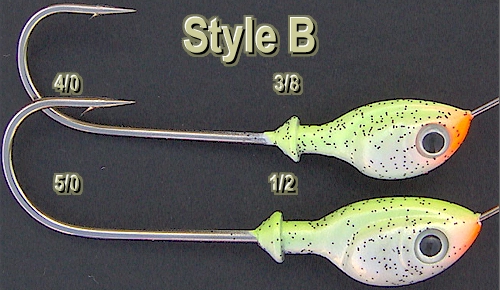
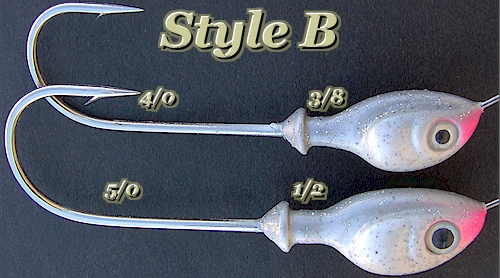
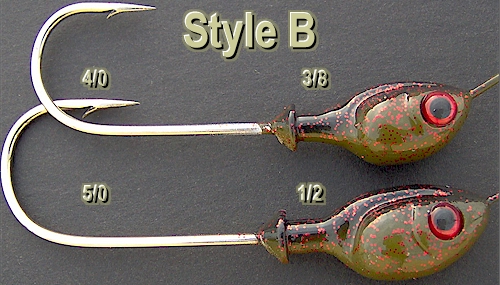
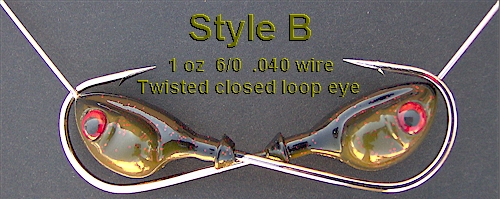
Style C Spinnerbait
The Style C head is one of the most highly popular styles worldwide and is sold under a large number of different brand names.It's widespread popularity is due to its stability in moving water or current, plus the Style C it is often used for deep slow-rolling. It's streamlined shape is also beneficial coming through weeds.
This legendary head is the darling of deep structure anglers. This head style helped Woo Daves win the 2002 Bassmaster Classic slow-rolling it in Chicago. When others are catching bass with deep-diving crankbaits or heavy Carolina rigs, that's when this style spinnerbait is at its very best. It is designed for ledges, channel edges and deep points. A favorite of river fishermen, it cuts fast water currents for river bass. The spear head cuts deep while the swollen belly adds stability.
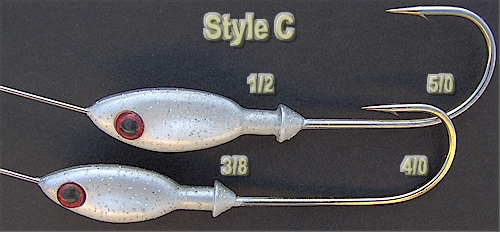
The Style C spinnerbait head is one of the most popular worldwide, and it is a mainstay of experienced anglers, including many of the world's top pros. The Style C head shape can be depended upon to do three things very well:
- It excels for fishing deepwater, channels, ledges, humps, slow-rolling or whatever deep duties you require, this spinnerbait is a deepwater staple.
- It's a stable and streamlined shape for fishing current or flowing water.
- It is often used for grinding through thick grass, keeping the nose arm wire relatively straight in line with the streamlined head.
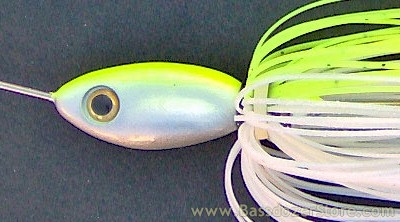
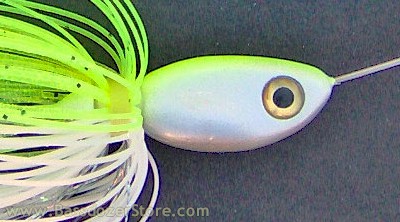
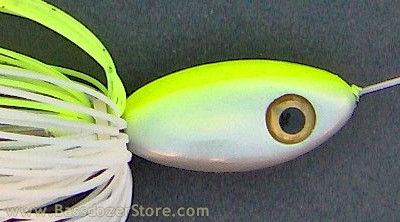
From top down: 3/4 oz Style C, 1 oz Style C, 1-1/2 oz Style C
Style D Spinnerbait
The Style D spinnerbait head has a thinner diameter on top. The sides angle outward for slightly wider bottom, plus a bulge of weight under the chin makes this head a very stable and attractive true runner. A unique feature of the Style D is larger "doll eyes" than most other spinnerbait head shapes.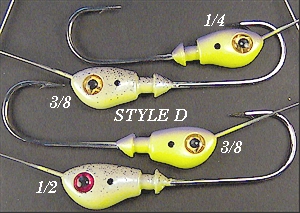
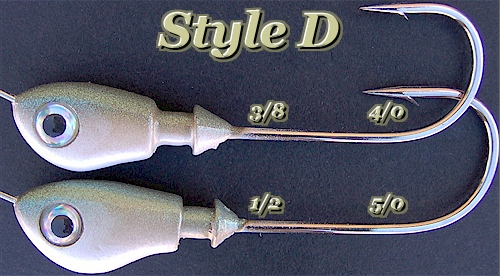
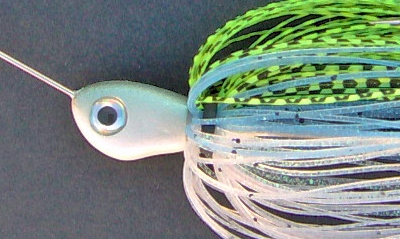
3/8 oz Style D
Style F Spinnerbait
The Style F head is a good one that is not as old or not as widespread as some of the others. Many anglers recognize that jigs come in different head shapes for different purposes. Some jig head shapes are better in weeds, rocks or wood. Anglers don't always realize the same concepts equally apply to spinnerbait heads. After all, a spinnerbait is just a punk rock version of a jig with its nose pierced by a wire and an earring dangling over its head. The Style F is for fishing dingy water, knocking against wood, bashing into stumps, bouncing off rocks better than some other spinnerbait head shapes. May be hard to see in the photo, but the face and belly is a bit boxy to deflect off hard stuff like rocks, stumps and limbs better than a more streamlined shape. These work well in every situation but excel most of all for bumping through stumps, limbs, logs and rocks better than standard spinnerbaits. The Style F is for getting into the wood and bumping limbs for the big ones!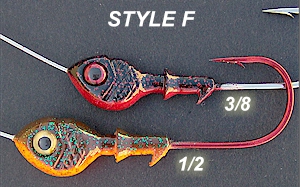
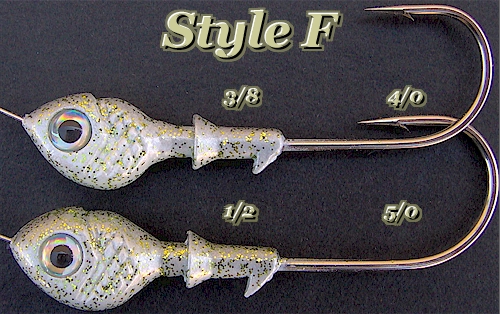
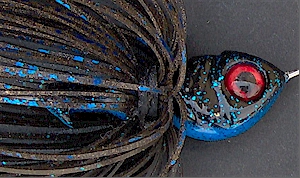
3/8 oz Style F
Style H Spinnerbait
Much of the weight mass of the Style H spinnerbait head is hidden under the skirt. That gives the appearance of a regular 1/4 oz spinnerbait, even though the Style H actually weighs 3/8, 1/2 or 3/4 oz, and the nose arm of the wire is shorter on the Style H, just like a standard 1/4 oz spinnerbait wire.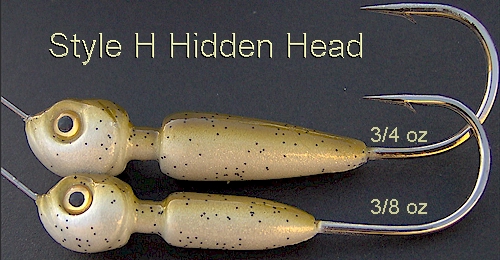
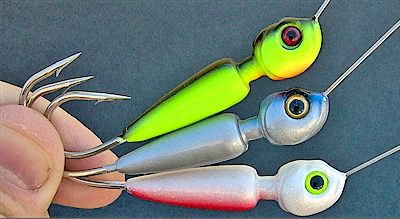
3/4 oz Style H Hidden Heads. The heavier 3/4 oz weight is especially suited for duty as a slow deep runner or as a fast subsurface burner type spinnerbait. Has the same .032 super wire arm. Used "normally" on a moderate retrieve, it will tend to seek its working level a little deeper than standard type 1/2 or 3/8 oz spinnerbaits. So you can think of it somewhat like a deep-diving crankbait model (compared to medium and shallow-diving cranks), except its a spinnerbait.
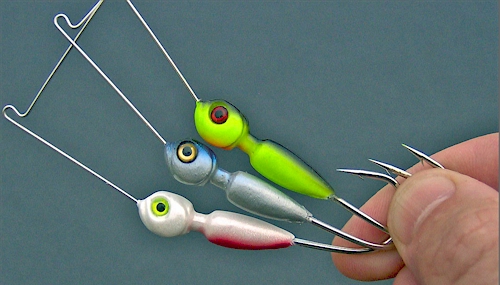
1/2 oz Style H Hidden Heads. Much of the mass or weight of the head is hidden beneath the skirt. However, I am a big advocate of showing off that hidden element. The new style EZ Skirts are a great dressing with a sparse peek-a-boo appearance that lets the hidden weight show through beneath the skirt . As you may be able to see in some of the dressed photos, the billowy, flared nature of the EZ Skirt lets the attraction of the hidden weight show throw the skirt, adding an element of allure that's not possible except by showing off a hidden head with an EZ Skirt.
So we're not trying to hide the hidden weight mass here, but using it to offer intriguing contrast and an additional dimension of appearance beneath the EZ Skirt.
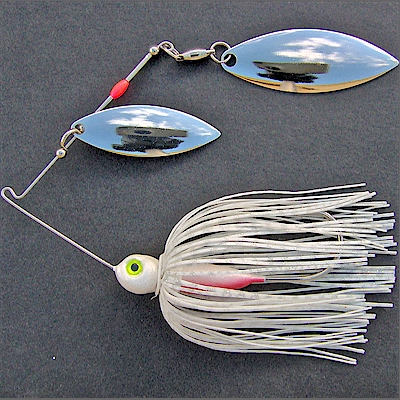
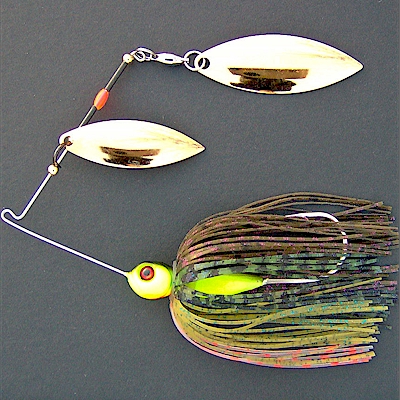
Many of the Style H are made using an .032 light wire diameter arm, which is about as light as wires reasonably run on bass spinnerbaits. True, there are a few other spinnerbaits on the market with wires of .030 or even .028 but they're rare, get the dickens twisted out of them and snap relatively quickly from metal vibration fatigue.
So .032 is about as light a wire as I feel one can reasonably use while still having some nominal level of fish-ability, to land fish played carefully with a forgiving rod, to somewhat hold up against twistage, and resist quick metal vibration fatigue.
Reason some anglers may want such a light .032 wire (despite the inherent drawbacks above) is their belief in and confidence that thinner diameter wire vibrates more and may at times attract more strikes than thicker wires that vibrate less. So the .032 wire (other things being equal) vibrates more than the most popular middle-of-the-road .035 or the heavy duty .040 wire arms most commonly used on bass spinnerbaits.
Super Wire Arm. What helps out a lot especially with such light .032 diameter wire is that the Style H's have Super Wire. So it is up to 30% stronger, gets bent less and vibrates up to 50% more than ordinary wire in lab tests. In actual fishing, I feel that 30% extra lab test strength equates to many times more bend-resistance on the water. So really, Super Wire is the way to go with light wire arms. You get a more durable, more fish-able bait, and it vibrates more, which is the reason some anglers opt for a light wire in the first place.
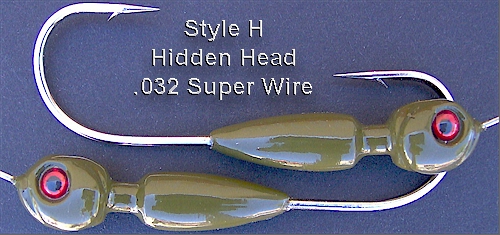
Style N Spinnerbait
What more can you say about the Style N? It's simply one of the best spinnerbait styles. It's made with a compact wire arm that compresses all the components - blades, skirt, head, hook - into a smaller package. It's pure dynamite!The Style N Spinnerbait is a compact type of bullet nose spinnerbait that is particularly good for coming through grass. Style N has a slightly shorter, more compact wire frame than usual, plus a slightly shorter shank spinnerbait hook than you see nowadays. It's concept is to pack all its punch into a slightly smaller package than usual. Think of this style as a "super concentrated formula" for a spinnerbait. These work well in every situation but excel most of all for snaking through grass.
In the photo below, you can see the standard Style B on right. Style B is one of the most popular spinnerbait shapes in the world. The photo shows the standard arm length and most common arm length used on the 1/2 oz Style B. Most standard spinnerbaits of all kinds have the same size frame, blades, nose, etc. In comparison, you can see the Style N on left has a smaller bullet nose, smaller nose arm, smaller blade arm and overall, the Style N is a more compact spinnerbait package.
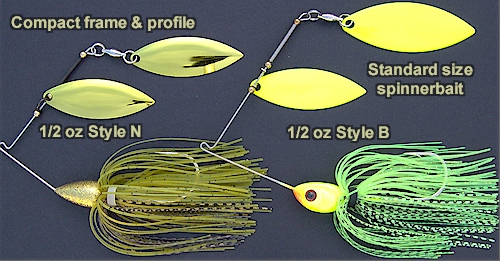
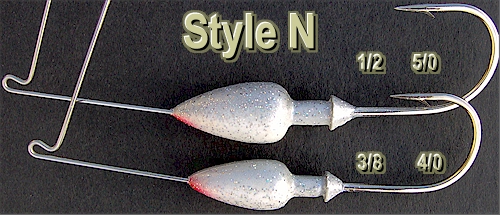
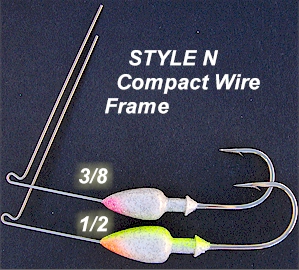
Style R Spinnerbait
Who knows how long hidden head spinnerbaits have been around? I reckon the first one I saw in modern times was about ten years back, made by a California company. I say "in modern times" since actually, the "original" spinnerbait, produced by a Mr. Jesse Shannon in the early 1900's was indeed a hidden head spinnerbait, with most of the bait's weight mass hidden under a big hank of bucktail crudely lashed over the hidden weight of that very first spinnerbait's head. So like the sayings go, "There's nothing ever truly new," or "What's old is new again" when it comes to hidden head spinnerbaits like the Style R shown here.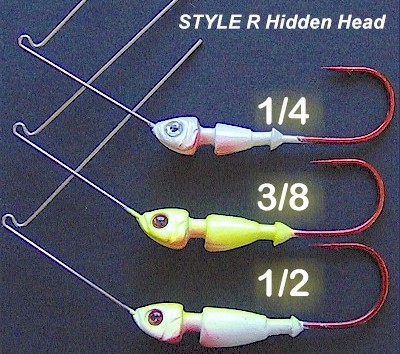
The Style R was made by one of the industry's leading lure designers. He has designed several of the first and still most popular hidden heads on the market - and really there aren't that many hidden heads on the market yet. Not only is he the father, shall we say, of his own hidden heads, but his originals have served as the examples for several other hidden heads on the market. So, in a sense, he's the grandfather of a couple other designs he knows that may have been loosely based on his original generation.
I once asked him the origins of the modern hidden heads. He felt Japan was the origin, and that's where he first got his ideas. In his fishing journeys to Japan, he found hidden heads to be much more popular there than in North America. Reason he felt was the requirement to fish downsized baits in Japan. It's the same reason that finesse applications like dropshot evolved in Japan first. Since much of the head mass is hidden, a 3/8, 1/2 or 3/4 oz spinnerbait can present the smaller profile of a 1/4 oz size, including compact wire frames and smaller blades that fit a 1/4 oz profile.
So the need to downsize to present a smaller bait, to fish finesse for heavily-pressured bass in Japan - that may be why and where the modern hidden heads evolved first. It seems some of the first in the USA, they appeared early on (about ten years ago) in southern California. This makes sense since it is the same route that dropshot and many other tactics and lures have taken from Japan into the USA, starting in southern California where many of the same Japanese finesse tactics also work swell for anglers in heavily-pressured California waters.
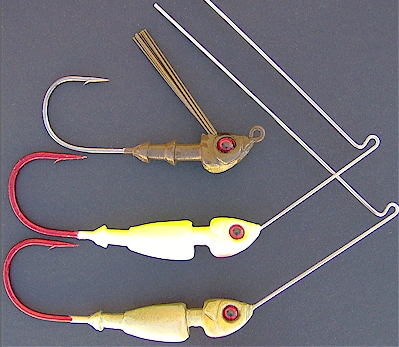
Top: 3/8 Swimming Jig. Middle: 3/8 Style R. Bottom: 1/2 Style R.
The Style R runs true and is extremely stable. The weight allocation is balanced to let you burn it rapidly if you want. Or rip or jerk it like a jerkbait, and it still maintains its equilibrium and upright posture. ideal on a dead fall or on a super slow to moderate retrieve. This is one of Bassdozer's best spinnerbait styles.
Most of the weight is hidden beneath the skirt, where there is also a trailer keeper cone collar to hold soft plastic trailers securely. Yes, there are days that spinnerbaits with trailers will get many more bites than without trailers - but most other spinnerbaits do not have a trailer keeper collar. This one does. The full cone provides 360 degrees of gripping power.

A look under the chin. Top: 3/8 swimming jig. Center: 3/8 Style R. Bottom: 1/2 Style R.
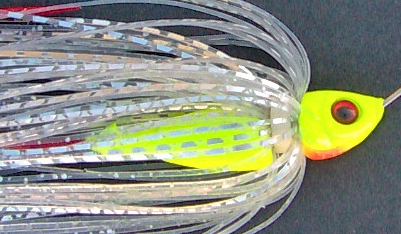
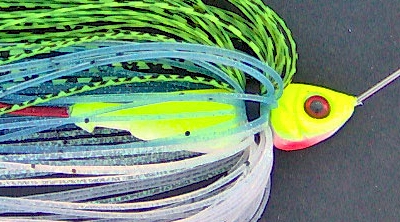
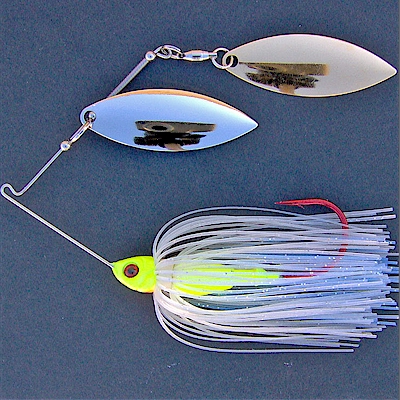
The bright chartreuse Style R hidden head presents a solid baitfish-shaped strike target that's only half-hidden beneath the billowy see-through skirt.
Style T Spinnerbait
The Style T is a heavy duty power fishing spinnerbait. Fish it hard. Fish it with power. It is incredibly productive.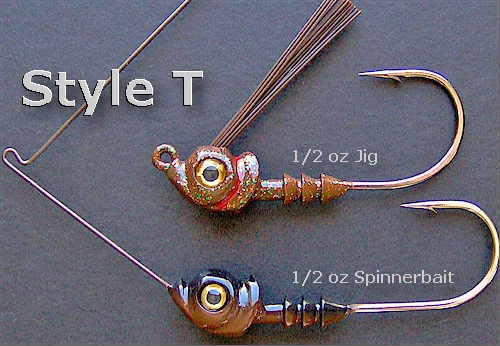
Power Anglers of the World Rejoice! Both the Style T jig and the Style T spinnerbait were built together to be power-fished together. The Style T head shape is designed from a flipping jig head, so the Style T is better than most spinnerbaits for coming through weeds and brushy cover like a weedless flipping jig.
- Style T Jig. The Style T jig flips into holes in grass and gets in and out of tight cover very well. But it also swims as good as any "swimming" jig. That was the main objective with the Style T jig - to have a heavy duty flipping jig that also swims as good as it flips. Not one or the other, but both. And that's what this jig does best of all - both flipping and swimming - especially in grass and thick weeds.
- Style T Spinnerbait. But that's not all! This Style T spinnerbait is the boon companion to the Style T flipping/swimming jig. This spinnerbait and jig are two peas in a pod, and the perfect pair for power anglers. When you are power fishing down a bank, you can use one rod to throw the Style T spinnerbait to prospect open water quickly for fish roaming beyond the outer grass lines, holding near adjacent drop-offs, and to sample open water areas in between patches of thick cover, as you use the electric motor to parley from one section of cover to the next. Keep in mind, the very corners of cover where the cover peters out and transitions into open water, these corners often have fish (good fish) watching these open corners from a short distance nearby, waiting for bait moving in and out of the area, and a spinnerbait can often be more productive than a jig in these corner transition areas.
This 1/2 oz Style T spinnerbait (center) is fashioned from a flipping/swimming jig head (top). This spinnerbait without the brushguard, is still quite snagless since the wire arm works much like the brushguard on a jig anyway. Like the jig that it's made from, this spinnerbait simply comes through heavy vegetation and brush better than many other jig or spinnerbait head shapes. That's what is the best feature of the 1/2 ox Style T spinnerbait model - working it through grass and brush like the flipping jig it is made from.
Also, note the high angle of the nose arm. This nose arm angle means it is pre-tuned to run horizontally. Depending on what blades are put on, it will need little or no wire tuning to run properly. This is a little tip (pre-tuned running posture) I picked up from the titanium arm spinnerbaits. Since a titanium arm cannot be bent, titanium must be "pre-tuned" to the correct running angle right out of the package. However, most all standard stainless wire arm spinnerbaits are not pre-tuned to proper running posture. The one you see here, the 1/2 oz Style T is pre-tuned to run right out of the package.
It has all the good properties of the swimming/flipping jig it's made from, now in a spinnerbait for heavy vegetation and brush.
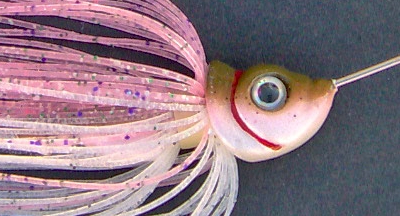
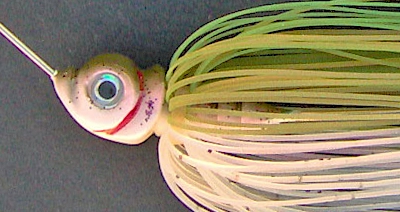
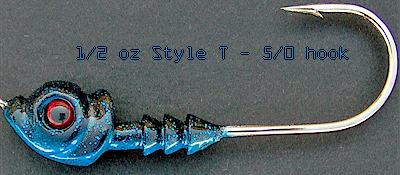

1/2 oz Style T spinnerbait heads
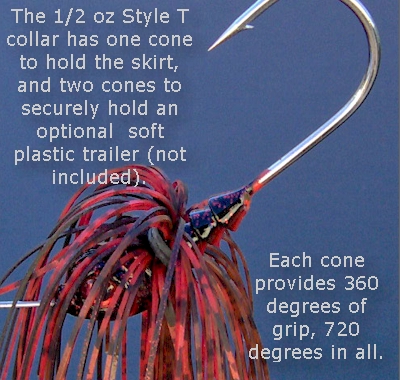
Triple Cone Cut Keeper Collar. Make no mistake, there are days that spinnerbaits with soft plastic trailers will get many more bites with than without trailers. Problem on most other spinnerbaits (and many jigs) is that they have no way to securely add a trailer bait. The Style T has a way. There is a triple cone trailer keeper collar to hold soft plastic trailers securely. A trailer may make the difference between a great day of solid hook-ups versus a vexing lot of half-hearted short strikes.
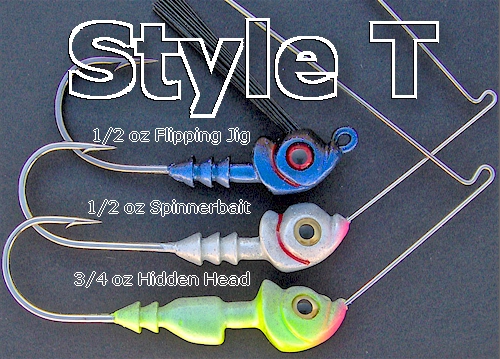
Trailer Options. Make no mistake, there are days that spinnerbaits with trailers will get many more bites with than without trailers. Problem on most other spinnerbaits (and many jigs) is that they have no way to secure a trailer bait. The Style T does. You will appreciate that. on the Style T, there is a double cone trailer keeper collar to hold soft plastic trailers securely. A trailer may make the difference between a great day of solid hook-ups versus a vexing lot lot of half-hearted misses.
Just like jigs, you can add a pork frog trailer, a plastic pork chunk or soft plastic trailers to these spinnerbaits. Also like jigs, the skirt bands have two "mouse ears" you may easily plug or unplug polycarbonate rattles. Also, you can just add a wavy-arm rattle strap on the hook bend, which is even easier to get on or off the spinnerbait. Rattles and/or rattle straps not included. Rattles and rattle straps sold separately.
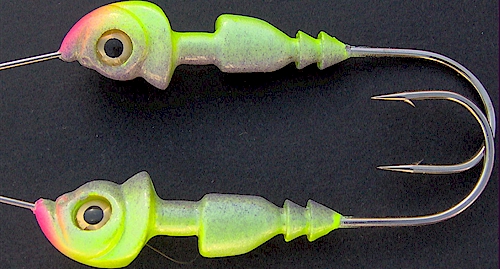
The Style T hidden head version is 3/4 ounce. It sports a 5/0 heavy hook. Fish it hard. Fish it with power.
Some of the head is distributed behind the skirt. In earlier hidden head designs, this was thought of as a good way to make the overall profile appear smaller - a smaller head size with the bulk of its weight hidden beneath the skirt to make the head appear smaller. In the Style T however, the body behind the skirt is for a different reason. It is meant to be seen - not hidden. It adds more body dimension, more shape, almost like building a small crankbait body contained within a spinnerbait - like a ship in a bottle. The skirt flowing around it is a separate fish attraction. The Style T hidden head is its own lure concept built beneath the skirt. In the Style T, the hidden head is used not to hide weight and reduce the profile, but to add an additional crankbait body type dimension beneath the skirt. This Style T body concept is not meant to be hidden. It's to be seen by and to trigger fish to strike at the inner body concept.
There is also a double cone trailer keeper collar to hold soft plastic trailers securely. Make no mistake, there are days that spinnerbaits with trailers will get many more bites than without trailers - but most other spinnerbaits do not have a trailer keeper collar. The Style T does. Each full cone provides 360 degrees of gripping power - times two - or 720 degrees of grip.
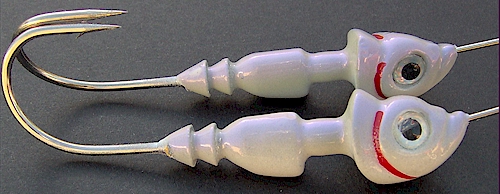
The 3/4 oz Style T Hidden Head is one of my own personal favorite and most productive spinnerbaits. This spinnerbait is h-e-a-v-y d-u-t-y. There aren't many hidden head spinnerbaits on the market to begin with, and certainly not heavy power fishing ones like this. I think one of the keys why it works so swell is that it stays consistently deeper. It really likes to stay about eight feet down even if you don't do anything to intentionally get it deeper. Of course, if you give it time to sink and work it in a slow-rolling fashion, it can get much deeper. But even on its own without doing anything special, the depth which this spinnerbait seeks is deeper than normal.
I often use such a heavier/deeper spinnerbait while having a lighter spinnerbait on a spinning rod on the deck, and I'll often alternate between the two in order to maximize the number of fish caught.. I usually start with the heavier/deeper one first, and when I feel I've had the majority of action that I am going to get on that one, then I'll go back through the productive areas with the lighter, higher-riding spinnerbait on the spinning rod, and almost always get a few more fish on the second presentation. Importantly, this "second round" are fish that would not have hit the first presentation again. Fish really do wise up to you quickly. Best odds are always on the first cast. Subsequent casts with the same lure often only serve to further reinforce that it should NOT be hit. So following through with a second different lure is a great way to catch active fish that have already rejected the first presentation.
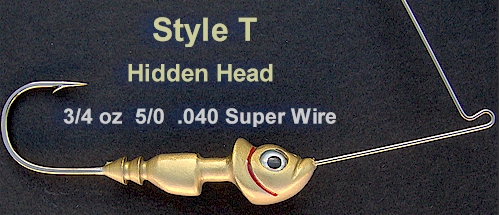

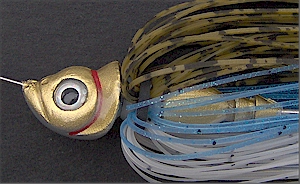
3/4 oz Style T Hidden Head
Which Weight Head to Use When?
When a good spinnerbait bite is on, I often work with three or four different spinnerbait weight sizes tied on different rods. True, this does show fish different skirt colors and different blade configurations, but what is more important to me is that different spinnerbait sizes present alternative depths, speeds, diverse size profiles, and varying mass displacement. Just like a good mechanic who may use several different sizes of wrenches to work on a vehicle, I will use several different sizes of spinnerbaits to work a good spinnerbait bite.- Light Spinnerbaits. I tend use the 1/4 oz spinnerbait for super slow presentations (such as in cold water), in super shallow bodies of water, or in downsized environments such as small streams and farm ponds. A 1/4 oz is not a lot of weight to counterbalance blade torque, so a 1/4 oz spinnerbait is more temperamental and prone to roll up on its side more than heavier spinnerbaits. A 1/4 oz is usually built with shorter wire arms and smaller blades to counteract roll. If light line is appropriate for the fishing conditions, then lighter line (for example, 8 lb test) can help add stability with a 1/4 oz spinnerbait. The shorter wire arms, smaller head shape, smaller hook (3/0 is often ideal), smaller blades plus trimming the skirt short gives you a
super compact, super slow-moving presentation for wary bass in shallow water.
- Medium Light. I tend to use a 3/8 oz spinnerbait to ride high, tossed tight up on the very shoreline or over emergent shoals. This is the smallest size I go with most days. This size I use more slowly and I tend to keep it up high near the surface. This gives me slowness, smallness and more of a high-floating, free-swimming buoyant presentation. I'll tend to pick this size for shallow water, say anything under six feet deep. Since I am using this size in shallow water, which often has a lot of cover, there are often panfish present. So I often use sunfish colors here, or a watermelon/brown color. This 3/8 oz spinnerbait is a "fixture" for me, meaning I rarely take it off. It is always worth a few casts in any fishing spot. Because it has a smaller,
more natural presence.
- Medium Spinnerbaits. The 1/2 oz spinnerbait serves me best most of the time. It's ideal when depth ranges from 6 to 18 feet deep. Averaged over a season, there is no doubt I make more casts with the 1/2 oz than with all other spinnerbait sizes. On days when I have had a good morning bite with the 1/2 oz, but the bite starts to shut down, that is when I tend to try the 5/8 oz, especially in a hidden head style. The 5/8 oz will run a little deeper, a little faster, and I will tend to fish it a little further out from shore after a shallow morning spinnerbait bite disappears.
- Medium/Heavy Spinnerbaits. I make fewer casts with the 3/4 oz on an average day. Even still, it is invaluable whenever I need a slightly deeper retrieve, faster speed or a little extra bulk. Keep in mind, a 3/4 oz has a bigger head, bigger hook, can handle more skirt and counterbalance more blade force than a 1/2 oz. What I mean is, the 3/4 oz can take more or bigger blades than the 1/2 oz. Also, when it becomes very windy, it may become necessary to go to the 3/4 oz. The 1/2 oz can be less effective at those times in terms of being able to cast it, control the line and feel the spinnerbait.
- Heavy Spinnerbaits. I make much use of 1 oz spinnerbaits - even in one foot of water. In shallow water, the 1 oz spinnerbait has a ton of presence. It is a big fish bait. Most anglers will never try this. So if you dare to try it, you can have all the 1 oz spinnerbait biters all to yourself in shallow water. Trust me, it works. I've hauled in many monster bass on 1 oz spinnerbaits in 1-2 feet of water.
I also use the one ounce as a bottom-bouncing presentation, slow rolling it 20 to 30 feet deep. Many anglers know about deep slow rolling, but few ever do it or they give up too quickly. It really is a game of patience. And the exact opposite, I use 1 oz blades as an extreme topwater presentation burning it back as fast as possible. Again, few anglers do this. Despite its lack of popularity, the 1 oz spinnerbait, no matter how you use it, tends to be a big bass presentation.
- Extra Heavy Spinnerbaits. As heavy as you can practically cast for bass is 1-1/2 ounces. It really requires a specialized rod and can be physically strenuous to use except for short period even for anglers in tiptop physical shape.
